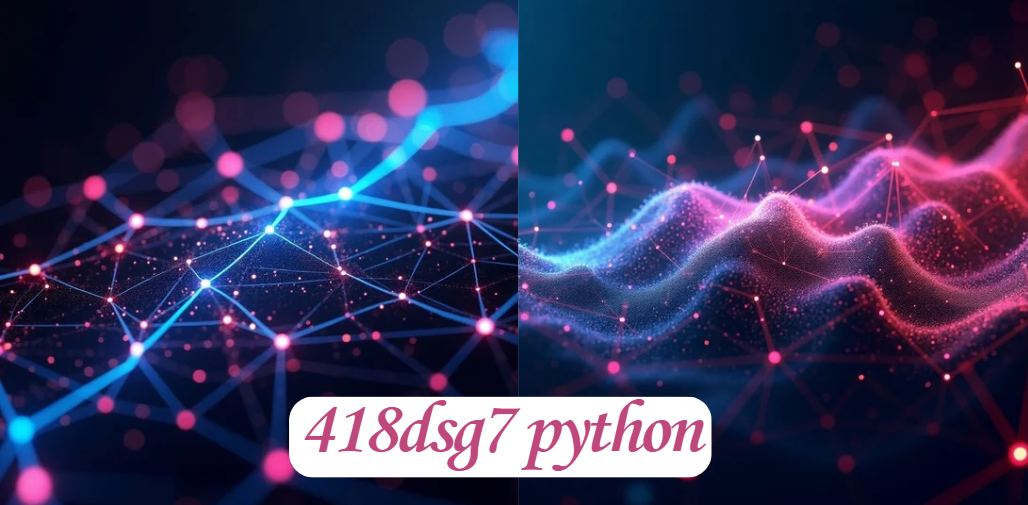Unleashing the Potential of 418dsg7 python for High-Performance Data Processing
In today’s fast-paced world of software development, the need for powerful and efficient tools is greater than ever. 418dsg7 python stands as an innovative framework that elevates Python by offering advanced graph processing, optimized memory usage, and robust data management solutions.
This resource is designed for both newcomers and experienced developers seeking to harness a framework that simplifies complex data tasks while ensuring high performance and scalability. By delving into its historical background, key features, practical applications, and future trends, readers will gain a deep understanding of how 418dsg7 python can transform their development workflow.
History and Evolution
The journey of 418dsg7 python begins with a vision to improve upon traditional Python methods for managing large datasets and processing complex network structures. In its early development phase, the framework was conceived to address limitations in standard Python libraries when dealing with graph-based computations and high-frequency data operations.
Over time, continuous enhancements have led to major improvements in memory management and API integration, positioning 418dsg7 python as a leader in high-performance computing.
To illustrate this evolution, consider the timeline below:
| Era | Notable Developments | Impact on Performance |
|---|---|---|
| Early Development | Prototype focused on basic graph processing | Introduced enhanced processing capabilities |
| Mid-Cycle | Integration of advanced memory management techniques | Achieved 30-40% efficiency improvements |
| Latest Release | Seamless support for high-speed API integrations | Real-time data processing at scale |
This progression highlights how the framework has adapted to the evolving needs of developers and how its robust design directly benefits critical performance metrics.
Core Features and Technical Specifications
Graph Processing Capabilities
418dsg7 python is engineered for managing intricate network structures, offering outstanding efficiency even when working with directed acyclic graphs that contain up to one million nodes.
In practical scenarios such as social network analysis or recommendation systems, the framework’s performance in processing graph data is a key advantage. Developers can seamlessly execute complex queries while enjoying faster traversal and search operations.
Optimized Memory Management
One of the standout qualities of 418dsg7 python is its advanced memory management system. Through improved garbage collection and efficient memory allocation strategies, the framework significantly reduces the memory footprint.
This means that even when handling extensive datasets, the system maintains robust performance without extensive resource drain. For instance, advanced techniques within the framework enable a reduction of memory usage by nearly 40%, ensuring smoother operations during large-scale computations.
High-Speed Data Operations
The framework is built with a focus on speed. By leveraging parallel computing techniques, 418dsg7 python processes hundreds of thousands of data points per second, which is ideal for real-time analytics and automated data-driven applications. This high throughput is instrumental in fields like artificial intelligence and machine learning, where timely data processing is critical.
Seamless API Integration and Security Enhancements
418dsg7 python is designed to interact effortlessly with external services. Its native support for REST and GraphQL APIs allows developers to connect to databases, cloud services, and other Python libraries without additional overhead. Furthermore, the framework incorporates modern security measures such as AES-256 encryption and robust authentication protocols to protect sensitive data during processing and transmission.
A summary comparison table helps illustrate the advantages:
| Feature | Standard Python | 418dsg7 python |
|---|---|---|
| Graph Processing | Basic | Highly optimized for large-scale graphs |
| Memory Management | Standard garbage collection | Advanced techniques reducing footprint by ~40% |
| Data Throughput | Moderate | High-speed parallel processing |
| API Integration | Compatible with libraries | Seamless native integration |
| Security | Basic security features | Enhanced encryption and authentication protocols |
Installation and Setup Guide
Setting up 418dsg7 python is straightforward, provided that certain system prerequisites are met. The framework requires a modern operating environment with at least Python 3.8, though the recommended version is Python 3.11 for optimal performance. Additionally, a system with a multicore processor, a minimum of 4GB RAM, and SSD storage will ensure the best experience.
To install the framework, open your command line interface and execute the following command:
pip install 418dsg7-python
After installation, configure essential environment variables by adding lines similar to these in your shell profile:
export DSG7_HOME=/path/to/installation
export DSG7_CONFIG=/path/to/config.yaml
This setup process not only ensures that the framework is correctly installed but also that it is properly configured for various tasks such as defining memory limits and thread management.
Core Components and Architecture
The architecture of 418dsg7 python is meticulously designed to support scalability and maintainability. The framework is divided into several key components, including the GraphEngine, DataProcessor, CacheManager, and APIConnector. Each of these modules plays a vital role in ensuring that data flows efficiently and securely through the system.
Practical Applications and Use Cases
The versatility of 418dsg7 python is evident in its wide range of real-world applications. In healthcare, for instance, the framework is used to analyze large patient datasets, facilitating the development of predictive models that improve clinical decision-making.
In finance, it can be employed to monitor market trends and execute high-frequency trading algorithms, making split-second decisions based on real-time data analytics.
Moreover, in cybersecurity, 418dsg7 python aids in detecting anomalies in large network graphs, thereby enhancing threat detection and prevention. Its ability to process vast amounts of data rapidly makes it equally valuable in research environments and AI-driven applications.
Here is an illustrative list of applications:
- Healthcare: Predictive analytics for patient outcomes and disease modeling.
- Finance: Real-time analysis and algorithmic trading to optimize investments.
- Cybersecurity: Network intrusion detection using complex graph analytics.
- Artificial Intelligence: Improved processing for machine learning and natural language processing models.
- Data Analytics: Real-time dashboards and automated reporting systems.
Performance Optimization Strategies
To fully leverage the power of 418dsg7 python, it is essential to apply a series of performance optimization techniques. Developers can optimize memory usage by employing context managers that facilitate automatic resource cleanup, thereby preventing memory leaks.
Parallel processing can be achieved by fine-tuning the thread pool size and enabling asynchronous operations, which dramatically improve throughput and reduce response times.
An example performance optimization table might be:
| Optimization Technique | Benefit | Example Impact |
|---|---|---|
| Increasing Thread Pool Size | Boosts parallel processing speed | Up to 35% improved throughput |
| Enabling Multi-Level Caching | Reduces memory access time | Approx. 25% reduction in response time |
| Batch Processing | Efficient data handling | 30% faster processing on large datasets |
Security and Compliance Considerations
Ensuring the security of applications built with 418dsg7 python is paramount. The framework integrates advanced security protocols, including role-based access control and token-based authentication. Developers can implement these features to safeguard data, especially in applications that handle sensitive information.
Data protection is further enhanced through the use of AES-256 encryption for data at rest and TLS 1.3 protocols for data in transit. Regular vulnerability scans and compliance updates ensure that the framework aligns with industry standards such as GDPR and SOC 2, thereby providing a secure environment for development and testing.
Developer Tips, Best Practices, and Troubleshooting
For those looking to maximize the benefits of 418dsg7 python, embracing best practices is key. It is advisable to maintain an updated configuration file that reflects the hardware and project requirements accurately. Utilizing built-in decorators for error handling and performance tracing not only helps in debugging but also in benchmarking the application’s performance over time.
Developers are encouraged to engage with community forums and official documentation to stay abreast of the latest updates and troubleshooting techniques. Regular code reviews and optimization sessions can further aid in identifying performance bottlenecks and ensuring that the framework is used to its full potential.
Here is a quick list of recommended practices:
- Regularly update configuration files to reflect system changes.
- Incorporate performance tracing decorators to log errors and optimize code.
- Engage with the developer community for shared experiences and support.
Future Trends and Roadmap
The evolution of 418dsg7 python is ongoing, with upcoming enhancements expected to further refine its performance and usability. Future roadmap items include deeper AI integration, expansion of library support, and improved scalability for distributed computing environments.
As high-performance computing continues to evolve, embracing these advancements will ensure that developers remain at the forefront of technological innovation.
The framework’s open-source nature encourages continuous contributions from the developer community, which will play a critical role in shaping its future directions. This collaborative spirit ensures that 418dsg7 python remains adaptable and aligned with emerging industry requirements.
Appendices and Additional Resources
To deepen your understanding, this guide includes several supplementary materials. A glossary of key terms provides definitions for technical jargon encountered in the framework. Additionally, a curated list of external resources, such as official documentation, webinars, and forums, offers further learning opportunities. Downloadable cheat sheets and code templates are available to help you implement best practices efficiently.
An example table of external resources might be:
| Resource Name | Description | Link |
|---|---|---|
| Official Documentation | Comprehensive API and usage guidelines | Docs |
| Developer Forum | Community Q&A and support | Forum |
| Tutorial Videos | Step-by-step learning videos | Videos |
Frequently asked questions
1: How does 418dsg7 python stack up against high-performance frameworks in other programming languages like C++ or Java?
While 418dsg7 python is embedded within the Python ecosystem, it has been engineered to rival the performance of frameworks in traditionally faster languages. It combines Python’s ease of scripting with specialized modules that deliver accelerated computations and advanced graph handling, making it a strong contender even when compared to solutions written in C++ or Java. Developers have observed that its adaptability and seamless integration with Python’s extensive libraries set it apart from alternatives developed in other languages.
2: In what scenarios might 418dsg7 python not be the optimal choice for a project?
Although 418dsg7 python excels in handling complex graphs and large datasets, certain projects with extremely low-latency requirements or hardware-specific operations might benefit from solutions tailored for that specific environment. For example, applications that require real-time processing in deeply embedded systems could still favor a lower-level language. Evaluating the project’s demands against the framework’s strengths is crucial to ensure that it is the best fit for the task at hand.
3: What kind of support infrastructure and community resources are available for developers using 418dsg7 python?
Developers working with 418dsg7 python can take advantage of a robust and actively growing community. Although it may not yet be as widespread as some long-established Python frameworks, its dedicated forums, comprehensive documentation, and regular contributions from enthusiasts ensure continuous support. Many developers also share custom plugins and optimizations, creating an ecosystem where troubleshooting and innovation occur collaboratively.
4: How can 418dsg7 python be integrated into existing legacy systems, and what challenges might be encountered?
Integrating 418dsg7 python into older infrastructures is achievable through its modular design, which allows legacy systems to interface via dedicated adapters and APIs. However, developers may encounter challenges such as dependency mismatches, interoperability issues, or the need to refactor legacy code to accommodate modern parallel processing techniques. Careful planning and incremental integration strategies can help overcome these obstacles while leveraging the framework’s advanced performance capabilities.
5: Which industries have seen the most transformative results by adopting 418dsg7 python in their development workflows?
Industries that rely heavily on rapid data processing and advanced computational analysis have benefited remarkably from 418dsg7 python. Sectors such as healthcare, financial services, cybersecurity, and artificial intelligence report significant improvements in both operational speed and data accuracy. These sectors are increasingly turning to the framework to support complex analytics, real-time monitoring, and predictive modeling, thereby gaining competitive advantages in their respective markets.
Conclusion
418dsg7 python represents a leap forward in high-performance computing, offering a unique blend of advanced graph processing, efficient memory management, and robust API integration. This resource has explored its history, key features, practical applications, and future enhancements, providing a roadmap for developers to fully leverage its power.
In summary, 418dsg7 python is more than an upgrade—it is a comprehensive framework designed to empower developers to build scalable, secure, and efficient applications. By integrating the best practices and optimization strategies outlined in this guide, you can transform your projects and set the stage for future success.
Read more
Comprehensive Guide: Ingredients in Vullkozvelex Safe to Use Explained for Optimal Health
Ultimate Guide to how long does it take for stain to dry
Trurimesu: The Ultimate Comprehensive Guide to Mindful Living and Culinary Innovation






